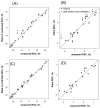Solution structure of tRNAVal from refinement of homology model against residual dipolar coupling and SAXS data
- PMID: 18787959
- PMCID: PMC2597493
- DOI: 10.1007/s10858-008-9267-x
Solution structure of tRNAVal from refinement of homology model against residual dipolar coupling and SAXS data
Abstract
A procedure is presented for refinement of a homology model of E. coli tRNA(Val), originally based on the X-ray structure of yeast tRNA(Phe), using experimental residual dipolar coupling (RDC) and small angle X-ray scattering (SAXS) data. A spherical sampling algorithm is described for refinement against SAXS data that does not require a globbic approximation, which is particularly important for nucleic acids where such approximations are less appropriate. Substantially higher speed of the algorithm also makes its application favorable for proteins. In addition to the SAXS data, the structure refinement employed a sparse set of NMR data consisting of 24 imino N-H(N) RDCs measured with Pf1 phage alignment, and 20 imino N-H(N) RDCs obtained from magnetic field dependent alignment of tRNA(Val). The refinement strategy aims to largely retain the local geometry of the 58% identical tRNA(Phe) by ensuring that the atomic coordinates for short, overlapping segments of the ribose-phosphate backbone and the conserved base pairs remain close to those of the starting model. Local coordinate restraints are enforced using the non-crystallographic symmetry (NCS) term in the XPLOR-NIH or CNS software package, while still permitting modest movements of adjacent segments. The RDCs mainly drive the relative orientation of the helical arms, whereas the SAXS restraints ensure an overall molecular shape compatible with experimental scattering data. The resulting structure exhibits good cross-validation statistics (jack-knifed Q (free) = 14% for the Pf1 RDCs, compared to 25% for the starting model) and exhibits a larger angle between the two helical arms than observed in the X-ray structure of tRNA(Phe), in agreement with previous NMR-based tRNA(Val) models.
Figures





Similar articles
-
Comparison of alignment tensors generated for native tRNA(Val) using magnetic fields and liquid crystalline media.J Biomol NMR. 2008 Feb;40(2):83-94. doi: 10.1007/s10858-007-9212-4. Epub 2007 Nov 17. J Biomol NMR. 2008. PMID: 18026844 Free PMC article.
-
Measurement of imino 1H-1H residual dipolar couplings in RNA.J Biomol NMR. 2009 Feb;43(2):121-9. doi: 10.1007/s10858-008-9293-8. Epub 2008 Dec 9. J Biomol NMR. 2009. PMID: 19067179 Free PMC article.
-
Magnetic field induced residual dipolar couplings of imino groups in nucleic acids from measurements at a single magnetic field.J Biomol NMR. 2007 Oct;39(2):91-6. doi: 10.1007/s10858-007-9181-7. Epub 2007 Aug 7. J Biomol NMR. 2007. PMID: 17680332
-
The use of residual dipolar coupling in studying proteins by NMR.Top Curr Chem. 2012;326:47-67. doi: 10.1007/128_2011_215. Top Curr Chem. 2012. PMID: 21952837 Free PMC article. Review.
-
Molecular Dynamics Simulations Combined with Nuclear Magnetic Resonance and/or Small-Angle X-ray Scattering Data for Characterizing Intrinsically Disordered Protein Conformational Ensembles.J Chem Inf Model. 2019 May 28;59(5):1743-1758. doi: 10.1021/acs.jcim.8b00928. Epub 2019 Mar 18. J Chem Inf Model. 2019. PMID: 30840442 Review.
Cited by
-
Integrative structural modeling with small angle X-ray scattering profiles.BMC Struct Biol. 2012 Jul 16;12:17. doi: 10.1186/1472-6807-12-17. BMC Struct Biol. 2012. PMID: 22800408 Free PMC article. Review.
-
Structure of the 30 kDa HIV-1 RNA Dimerization Signal by a Hybrid Cryo-EM, NMR, and Molecular Dynamics Approach.Structure. 2018 Mar 6;26(3):490-498.e3. doi: 10.1016/j.str.2018.01.001. Epub 2018 Feb 2. Structure. 2018. PMID: 29398526 Free PMC article.
-
Structural Biology of the Enterovirus Replication-Linked 5'-Cloverleaf RNA and Associated Virus Proteins.Microbiol Mol Biol Rev. 2020 Mar 18;84(2):e00062-19. doi: 10.1128/MMBR.00062-19. Print 2020 May 20. Microbiol Mol Biol Rev. 2020. PMID: 32188627 Free PMC article. Review.
-
Chemo-enzymatic synthesis of site-specific isotopically labeled nucleotides for use in NMR resonance assignment, dynamics and structural characterizations.Nucleic Acids Res. 2016 Apr 7;44(6):e52. doi: 10.1093/nar/gkv1333. Epub 2015 Dec 10. Nucleic Acids Res. 2016. PMID: 26657632 Free PMC article.
-
A method for helical RNA global structure determination in solution using small-angle x-ray scattering and NMR measurements.J Mol Biol. 2009 Oct 30;393(3):717-34. doi: 10.1016/j.jmb.2009.08.001. Epub 2009 Aug 8. J Mol Biol. 2009. PMID: 19666030 Free PMC article.
References
-
- Al-Hashimi HM, Valafar H, Terrell M, Zartler ER, Eidsness MK, Prestegard JH. Variation of molecular alignment as a means of resolving orientational ambiguities in protein structures from dipolar couplings. J Magn Reson. 2000;143:402–406. - PubMed
-
- Allain FHT, Varani G. How accurately and precisely can RNA structure be determined by NMR? J Mol Biol. 1997;267:338–351. - PubMed
-
- Bhatnagar J, Freed JH, Crane BR. Rigid body refinement of protein complexes with long-range distance restraints from pulsed dipolar ESR. Meth Enzym. 2007;423:117–133. - PubMed
-
- Brunger AT, Adams PD, Clore GM, DeLano WL, Gros P, Grosse-Kunstleve RW, Jiang JS, Kuszewski J, Nilges M, Pannu NS, Read RJ, Rice LM, Simonson T, Warren GL. Crystallography & NMR system: A new software suite for macromolecular structure determination. Acta Crystallographica Section D-Biological Crystallography. 1998;54:905–921. - PubMed
Publication types
MeSH terms
Substances
Grants and funding
LinkOut - more resources
Full Text Sources

